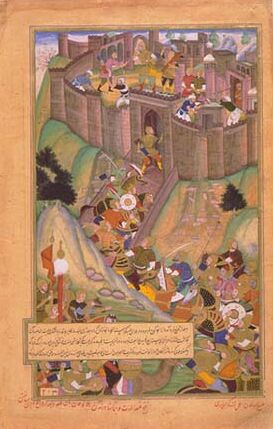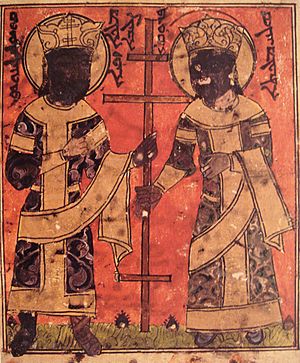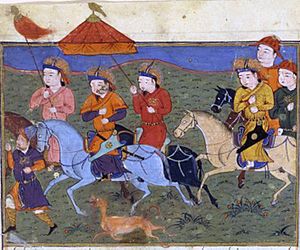Hulagu Khan facts for kids
Quick facts for kids
|
|
|---|---|
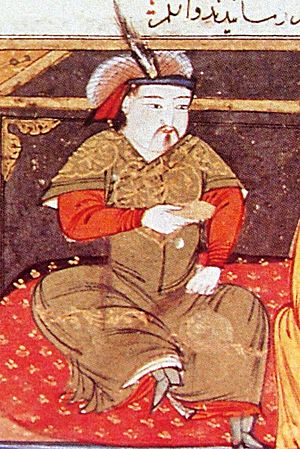
Painting of Hulagu Khan on Rashid-al-Din Hamadani, early 14th century.
|
|
| Ilkhan | |
| Reign | 1256 – 8 February 1265 |
| Successor | Abaqa Khan |
| Born | c. 1217 Mongolia |
| Died | (aged 47) Zarrineh River |
| Burial | Shahi Island, Lake Urmia |
| Consort |
|
| Issue | See below |
| House | Borjigin |
| Father | Tolui |
| Mother | Sorghaghtani Beki |
| Religion | Tengrism, Buddhism |
| Tamgha |  |
Hulagu Khan (born around 1217 – died February 8, 1265) was a powerful Mongol ruler. He was a grandson of the famous Genghis Khan and a brother to other important leaders like Möngke Khan and Kublai Khan. Hulagu led a huge Mongol army that conquered a large part of Western Asia.
Under Hulagu's command, the Mongol Empire grew significantly in the southwest. He founded the Ilkhanate in Persia, which was a kingdom that later influenced the modern country of Iran. One of his most famous actions was the siege of Baghdad (1258). This event greatly changed the Islamic Golden Age and shifted the center of Islamic power to Cairo.
Contents
Who was Hulagu Khan?
Hulagu was born in 1217 to Tolui, one of Genghis Khan's sons, and Sorghaghtani Beki. His mother was a very influential princess from the Keraites tribe. Not much is known about Hulagu's early life. However, one story says he met his grandfather Genghis Khan in 1224, along with his brother Kublai Khan.
Hulagu's Military Campaigns
In 1251, Hulagu's brother, Möngke Khan, became the Great Khan, the supreme leader of the Mongol Empire. Möngke gave Hulagu a big mission: to lead a massive Mongol army and conquer or destroy the remaining Muslim states in southwestern Asia.
Hulagu's main goals were:
- To defeat the Lurs in southern Iran.
- To destroy the Nizari Ismaili state, also known as the Assassins.
- To conquer or destroy the Abbasid Caliphate in Baghdad.
- To take over or destroy the Ayyubid states in Syria, especially Damascus.
- To conquer or destroy the Mamluk Sultanate of Egypt.
Möngke told Hulagu to be kind to those who surrendered peacefully. But he also ordered him to completely destroy anyone who resisted. Hulagu followed these instructions very strictly, especially the part about destroying those who fought back.
Hulagu set out in 1253 with possibly the largest Mongol army ever put together. It was said that two-tenths of the empire's fighting men were gathered for his army. He arrived in Transoxiana in 1255. He easily defeated the Lurs. The Assassins even surrendered their strong fortress of Alamut without a fight in early 1256. They accepted a deal that saved their people's lives. Hulagu chose Azerbaijan as his main base of power.
The Siege of Baghdad
Hulagu's Mongol army marched towards Baghdad in November 1257. Baghdad was a very important city, known for its learning and culture. When they reached the city, Hulagu split his forces to attack from both sides of the Tigris River. Hulagu demanded that the city surrender, but the caliph, Al-Musta'sim, refused.
The Mongols began their siege on January 29, 1258. They built defenses and used powerful catapults. The battle was quick for a siege. By February 5, the Mongols had control of part of the city wall. The caliph tried to talk peace, but Hulagu refused. On February 10, Baghdad surrendered.
On February 13, the Mongols entered the city and began a week of destruction. The Grand Library of Baghdad, which held countless valuable books and historical documents, was destroyed. Many citizens tried to escape but were caught by Mongol soldiers. Historians estimate that anywhere from 90,000 to a million people died.
Mosques, palaces, libraries, and hospitals—beautiful buildings built over generations—were burned down. The caliph was captured and forced to watch his city destroyed. Most historians believe the caliph was rolled up in a rug and horses were ridden over him. This was because Mongols believed royal blood should not touch the earth. Baghdad remained a ruined city for many years.
Conquest of Syria
In 1260, Hulagu's forces joined with Christian armies from the region. These included the army of the Armenian Kingdom of Cilicia and the Franks of Bohemond VI of Antioch. Together, they conquered Muslim Syria, which was ruled by the Ayyubid dynasty. They captured Aleppo and, under the Christian general Kitbuqa, took Damascus on March 1, 1260.
This invasion effectively destroyed the Ayyubid dynasty, which had been very powerful. With Baghdad ruined and Damascus weakened, the main center of Islamic power moved to Cairo, the capital of the Mamluk sultan.
Hulagu planned to send his army further south towards Cairo. However, there wasn't enough food for his large army in Syria. Also, Mongols often moved their troops to cooler areas for the summer. So, Hulagu took his main army back to Iran. He left about 20,000 soldiers under Kitbuqa, believing this was enough. Hulagu then went to Mongolia because his brother Möngke Khan had died, and he needed to be part of choosing the next Great Khan.
When the Mamluk Sultan Qutuz in Cairo heard that only a small Mongol force remained, he quickly gathered his army. He invaded Palestine and allied with another Mamluk leader, Baybars. They wanted to protect their lands and get revenge for the Mongol attacks on Baghdad and Damascus.
The Mongols tried to make an alliance with the Christian Crusaders in Acre. But the Pope had forbidden such an alliance. The Crusaders also had problems with the Mongols. Instead, the Crusaders chose to stay neutral. They even allowed the Mamluk army to march through their territory and resupply near Acre.
Battle of Ain Jalut
In 1260, the Mamluk Sultan Qutuz and his forces met the Mongol army of about 20,000 men at the 'Spring of Goliath' (Ain Jalut) in the Jezreel Valley. The battle lasted for many hours. The Mamluk leader Baybars used hit-and-run tactics to draw the Mongols into a trap.
Baybars and Qutuz had hidden most of their army in the hills. When the Mongol leader Kitbuqa chased Baybars's fleeing troops, the Mongols found themselves surrounded. The hidden Mamluk troops attacked from the sides, and Qutuz attacked from the rear. Almost the entire Mongol army, including Kitbuqa, was killed or captured. The Battle of Ain Jalut was a major turning point, marking the furthest point of Mongol conquest in the Middle East.
Civil War Among Mongols
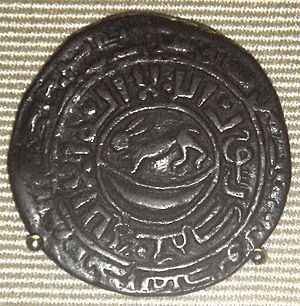
After his brother Kublai Khan became the Great Khan, Hulagu returned to his lands in 1262. He planned to attack the Mamluks again to get revenge for the defeat at Ain Jalut. However, he was drawn into a civil war with Berke Khan. Berke Khan was a Muslim and another grandson of Genghis Khan. He was very angry about Hulagu's destruction of Baghdad and allied himself with the Mamluks.
Berke Khan started many raids on Hulagu's lands. In 1263, Hulagu suffered a big defeat when he tried to invade north of the Caucasus mountains. This was the first open war between different Mongol groups, and it showed the end of the unified Mongol Empire.
Even though Berke was Muslim, he first hesitated to fight Hulagu because of their Mongol brotherhood. He said, "Mongols are killed by Mongol swords. If we were united, then we would have conquered all of the world." But economic problems and Hulagu's actions led him to declare a holy war against Hulagu.
Messages to Europe
Hulagu's mother, Sorghaghtani, was a Christian from the Church of the East. Hulagu himself was friendly towards Christians. His favorite wife, Doquz Khatun, was also a Christian, as was his close friend and general, Kitbuqa.
Hulagu sent several messages to Europe. He wanted to form an alliance with European kings and princes against the Muslims. In 1262, he sent his secretary to "all kings and princes overseas." However, this message was stopped in Sicily.
On April 10, 1262, Hulagu sent a letter to Louis IX of France, offering an alliance. It's not clear if this letter ever reached Louis IX in Paris. Despite these efforts, Hulagu and his successors were never able to form a strong alliance with Europe. However, Mongol culture became popular in the West during the 13th century. Many children in Italy were even named after Mongol rulers, including Hulagu.
Hulagu's Family
Hulagu had many wives and concubines, and at least 21 children.
His main wives included:
- Guyuk Khatun
- Qutui Khatun
- Yesunchin Khatun
- Dokuz Khatun
- Öljei Khatun
Some of his notable children were:
- Abaqa Khan (who became his successor)
- Tekuder
- Möngke Temür
- Yoshmut
- Baydu
Death and Legacy

Hulagu Khan became very sick in January 1265 and died the next month, on February 8, 1265. He died near the Zarrineh River and was buried on Shahi Island in Lake Urmia. His funeral was unique for the Ilkhanate because it included human sacrifice. His tomb has never been found.
Hulagu Khan created the Ilkhanate, which set the stage for later dynasties in Iran and eventually the modern country of Iran. His conquests also brought European and Chinese influences to Iran. This mix, along with support from his successors, helped Iranian architecture become very special. During his rule, Iranian historians started writing in Persian instead of Arabic.
It is believed that Hulagu converted to Buddhism later in his life, even though his wife Doquz Khatun was Christian. A Buddhist temple built in Khoy shows his interest in that religion. Letters from Tibetan monks confirm he was a lifelong Buddhist.
Hulagu also supported scholars like Nasir al-Din al-Tusi, who did important research at the Maragheh observatory. His rule as the leader of the Ilkhanate was generally peaceful and accepting of different cultures and religions.
In popular media
- Portrayed by Kurt Katch in Ali Baba and the Forty Thieves (1944)
- Portrayed by Pran in the 1956 Indian film Halaku.
- Portrayed by Öztürk Serengil in Cengiz Han'ın Hazineleri (1962)
- Portrayed by Zhang Jingda and Zhang Bolun in The Legend of Kublai Khan (2013)
Images for kids
See also
 In Spanish: Hulagu para niños
In Spanish: Hulagu para niños



